Channeling the ’40s with a half-moon manicure
If I do say so myself, I’m terrifically talented at wasting time. And so I recently whiled away an hour or three on a half-moon manicure, a ’40s look that has become popular again. The “half-moon” at the base of the nail is left plain or painted in a color that contrasts with the rest of the nail. I decided to give it a whirl after admiring it on Dita Von Teese and reading a how-to by Beth Shapouri at Glamour.
Beth came up with the nifty idea of using reinforcement labels as stencils for the half-moons. (The labels are little round white stickers used to keep papers in those ancient devices called three-ring binders. You can buy them at office-supply stores.)
I started with two coats of clear base, let it dry well, then placed the labels and painted on Revlon’s Frankly Scarlet (745), $5 at drug stores. This technique is a good start, but it does take some experimentation and practice to perfect the size of the half-moons. (My nails are a tad stubby now so I wanted small-ish moons, proportionate to shorter nails.)
The lower you place the label, the smaller and more elongated the half-moon. A snag I had is that the sides of the label don’t stick especially well and they really need to lay flat so I added a bit of tape to secure them. After the red dried and I removed the labels, I still had to “tweak” (ie, a Q-tip dipped in remover and a little freehand filling in with the red polish). This would be especially problematic had I gone two-tone (a metallic or neutral instead of a clear base) as I had hoped to do with my MAC 5 Naughty Little Vices Nail Lacquer. But I decided to keep it simple until I got the hang of it.
![2010-12-24_15.56.30[1]](http://www.filmnoirblonde.com/wp-content/uploads/2010/12/2010-12-24_15.56.3012-300x225.jpg) Still, after some trial and error, and a clear top coat, my nails looked pretty good. The bottom line is if you like fussing with beauty projects, creating this retro look is a fun challenge, especially if you’re bundled up inside on a snowy or rainy day. But, if you’re an impatient painter, it’s best left to a pro. Either way, it’s definitely a nice noir twist on a manicure and Frankly Scarlet is ideal for New Year’s Eve. Now if I can just figure out, a la the WW2-era, how to paint “silk stockings” on my gams and draw fake seams on the backs of my knees. 😉
Still, after some trial and error, and a clear top coat, my nails looked pretty good. The bottom line is if you like fussing with beauty projects, creating this retro look is a fun challenge, especially if you’re bundled up inside on a snowy or rainy day. But, if you’re an impatient painter, it’s best left to a pro. Either way, it’s definitely a nice noir twist on a manicure and Frankly Scarlet is ideal for New Year’s Eve. Now if I can just figure out, a la the WW2-era, how to paint “silk stockings” on my gams and draw fake seams on the backs of my knees. 😉
Comments
Wilmington unwraps noir in ‘Wonderful Life’
Scenario for Christmas: A whimsical guardian angel shows a good-hearted small-town guy, on the brink of suicide, what would have happened if he’d never lived and what a difference his life really made to everyone around him. You’ve seen it before, but it always works. And it always will.
Frank Capra‘s holiday masterpiece “It’s a Wonderful Life” is an exhilarating mix of angelic fantasy and small-town comedy, of political fable and poetic license, of Norman Rockwell and film noir.
The last act of this beloved Christmas classic — where George Bailey (James Stewart, in his favorite role) sees his beloved hometown of Bedford Falls turned into a dark semi-urban nightmare, as it would have been if it were run by George’s rich, greedy nemesis, Old Man Potter (Lionel Barrymore) — is a pure film-noir nightmare, with a tormented protagonist, a world bent into bad-dreams-come-true and a fate that (temporarily) can’t be escaped.
There are lots of real film-noir mainstays in the cast, people who fit easily into the noir universe — notably Gloria Grahame (“In a Lonely Place,” “Human Desire,” “The Big Heat”) as the town’s blonde bombshell Violet; Thomas Mitchell (“Dark Waters,” “The Dark Mirror,” “While the City Sleeps”) as George’s absent-minded Uncle Billy; Barrymore (“Key Largo”) as the evil banker Potter; and Sheldon Leonard (“Decoy”) as tough Nick the bartender.
The movie’s crack Capra ensemble also boasts Ward Bond (“The Maltese Falcon,” “On Dangerous Ground,” “Kiss Tomorrow Goodbye”) and Frank Faylen (“The Blue Dahlia,” “Detective Story,” “The Sniper”) as cop and cabbie (and “Sesame Street” namesakes) Bert and Ernie. And of course there’s the great, shy, stammering Stewart himself, who went on to make such classic noirs as “Call Northside 777,” plus, for Hitchcock, “Rope,” “Rear Window” and “Vertigo.”
The script, by turns witty and sentimental, was adapted from a Christmas fable by poet Philip Van Doren Stern. “Life” had a raft of A-list writers, namely Frances Goodrich and Albert Hackett, the husband-wife team who adapted Dashiell Hammett‘s “Thin Man” for the movies. On “Life,” they received uncredited assistance from such stalwart noir writers as Jo Swerling (“Leave Her to Heaven”), Dalton Trumbo (“Gun Crazy”), Clifford Odets (“Sweet Smell of Success”) and the famously acerbic Dorothy Parker (you heard me right).
Lead cinematographer Joe Biroc (“Cry Danger,” “The Killer That Stalked New York”) gives the movie a distinctly nightmarish look.
The point of cataloging “Life’s” noir vets is that most of the talent in the movie were known more for film noir than the simplistic goody-two-shoes stuff people mistakenly feel is the essence of both “It’s a Wonderful Life” and Capra-corn. Capra wanted smart, sophisticated collaborators who knew what happened when the lights went off. Noir people.
Capra had already experimented with a mixture of humor, sentiment and noir in his 1944 comedy of murders, with Cary Grant, “Arsenic and Old Lace” but “Wonderful Life” has the style down pat. We see George’s kindness, generosity and sometimes-antic humor shining throughout his difficult but rewarding life as recounted up above to his guardian angel Clarence (Henry Travers). But then we see him in a downpour of terror and anguish when he suddenly faces financial ruin, flees his family, wrecks his car, stands on a bridge and contemplates suicide. And finally at the “Auld Lang Syne” end, we get the Bailey family pride and joy when the nightmare ends. Well, some great noirs have happy endings too …
In many ways, of course, “It’s a Wonderful Life” is Charles Dickens‘ “A Christmas Carol” in reverse. (Barrymore was famous for his interpretation of Ebenezer Scrooge, which he reprised every year at Christmas on radio and which he probably would have played for the 1938 MGM movie, had he not been wheelchair-bound by the time of its production.)
Anyway, it all jelled into a movie and an experience, both spinetingling and heartwarming, that nobody ever forgets: On a magical Christmas Eve, a good man understands the meaning of his life and the effects of selflessness, just as Dickens’ Scrooge sees the consequences of his own selfishness.
Most importantly, “Life” had Frank Capra, a directorial magician who could mix comedy and drama, move audiences deeply and also make them laugh, like almost no one else in Hollywood history. Capra always thought this was his best movie, even though it was a horrible disappointment to him financially and professionally. The original 1946 audiences and critics were mixed, and the film’s receipts failed to support the new company, Liberty Films, that Capra was trying to set up with his friends George Stevens, William Wyler and John Huston. Largely because of “Life,” they lost their Liberty.
“It’s a Wonderful Life” takes you right over the edge. Almost. It’s a wonderful picture: a very funny, often charming, but also terrifying movie about life’s most horrible disappointments, about all your nightmares coming true and all your dreams being torn apart. And that was echoed in real life. George Bailey failed (for a while), and Frank Capra failed (for a while) too.
But Capra was right. This is his best movie. I can’t keep a dry eye when George’s brother Harry (Todd Karns) toasts him under the Christmas tree as “the richest man in town,” the Bedford Falls crowd sings “Auld Lang Syne” and they find Zuzu’s petals. I don’t even want to.
If you’ve never been moved, even slightly, when Harry raises that glass, everybody sings and George hears the bell — well, the hell with you. “Bah, Humbug,” as Potter would say. But the Bedford Falls folks are still going to shout: “Merry Christmas everyone!”
Noir people too.
You can read more of Michael Wilmington’s reviews at Movie City News.
Author photo by Victor Skrebneski; copyright Victor Skrebneski
Comments
MAC nails it with five-color polish set
Looking for a last-minute gift for your favorite mani-pedi diva? MAC Cosmetics’ 5 Naughty Little Vices Nail Lacquer, $25.50, is a must-have for any polish-happy bad girl.
This limited-edition collection contains five colors in mini-size bottles. Asiatique is a fresh, crisp red that’s perfect for Christmas gatherings and sure to turn Santa’s head. That might not sit well with Mrs. Claus, but she’ll forgive and forget once she tries Beyond Jealous, a festive, modern forest-green. The grape-colored Vintage Vamp, classic and versatile, gives you lots of looks for the holidays and beyond.
Night owls will adore Nocturnelle, a gun-metal gray that with a few coats becomes a delicious pitch-black. My favorite is Vice is Nice, a soft, great-looking gold that goes with just about everything. I’m especially liking gray and gold this season, so I’ve been wearing Vice is Nice quite a bit and I’m looking forward to trying it with red or green for a vintage half-moon manicure.
MAC’s polish is light, sheer and long lasting. Two quick coats of Vintage Vamp lasted several days (and endured a trip from LAX) with no chips in sight. And the darling mad-about-plaid container in a clear-plastic pouch with ribbon means there’s no need to wrap.
For more info, visit MAC; pick it up at MAC shops or department stores.
Product Source: From my own collection; I did not receive products or compensation from MAC Cosmetics.
Comments
Femme fatale fragrances: 10 bad-ass bottles to die for
Even if you’re a makeup minimalist, every femme fatale worth her revolver needs a signature scent to call her own. The holidays are always a great time to see if your perfume collection could use a few new pretty bottles. And of course fragrances make wonderful gifts for fellow vamps and virile fellows when you have an idea of the recipient’s taste. Dig in!
Norell eau de toilette This retro scent reminds me of an old friend of my mother’s who ran her own business, liked to eat Haagen-Dazs Swiss almond vanilla in the middle of the afternoon and always had her nails done in Jungle Red. Norell was one of her favorites in the late ’70s. Notes of musk, vanilla, moss and myrrh meet sassy florals jasmine, rose and ginger lily.
As long as we’re on memory lane, Norell also reminds me of a handsome senior financial editor I used to know who always complimented me when I wore a little Norell behind my ears. It’s a formidable fragrance for a woman who knows what she wants and how to get it. $25.49 for 3.3 ounces at Target
Victoria’s Secret Sexy Little Things Noir eau de parfum Winner of the 2009 FiFi fragrance of the year award, this fruity floral blends nectarine, amber and cattleya orchid, according to the company. Put a little of this on and then try not to flirt. It will put you in the mood, period. The black bottle and retro pump with tassel (what a cute gift!) would do Lana Turner proud. $29 for .85 ounces; $39 for 1.7 ounces; $49 for 3.4 ounces
Michael Kors Very Hollywood eau de parfum True, this fragrance is more starlet than Stanwyck, what with its soft feminine notes (mandarin, gardenia and vetiver) and clean, dare I say wholesome, finish. But even tough ladies are tender sometimes and when you feel the need for a light and luscious confection, Very Hollywood should do the job nicely. $45 for 1 ounce eau de parfum; $65 for 1.7 ounces; $85 for 3.4 ounces
Jo Malone Pomegranate Noir cologne Fruity with a smoky edge, this cologne, inspired by a red silk dress and that jewel of the desert, the pomegranate, is sure to bring out your wily side. And Jo Malone’s light singular scents are designed to be used in “the art of fragrance combining.” I like to mix Pomegranate Noir with French Lime Blossom or Vintage Gardenia. I’m also partial to the woody Wild Fig & Cassis, on its own. The black and white packaging is so clean, simple and elegant, Jo Malone is a must on any girl’s vanity table. $55 for 30 ml cologne; $100 for 100 ml cologne
Gucci Guilty eau de toilette “She’s got something on her conscience,” says Raymond Massey in “Woman in the Window” from 1944. “But what woman hasn’t?” Just ask Gucci, maker of this oriental floral fragrance with top notes of pink pepper, a heart note of lilac and base notes of patchouli and amber. Playing on neo-noir appeal, Evan Rachel Wood and Chris Evans heat up the screen in Gucci Guilty’s commercial, directed by Frank Miller. Mmmm, bring it on! $55 for 30 ml; $75 for 50 ml; $95 for 75 ml
D&G L’Imperatrice eau de toilette Fresh and clean, yet sophisticated, you could wear this just about anywhere. Dolce & Gabbana says the inspiration for this fragrance collection came from personality types. L’Imperatrice stems from The Star: “Flamboyant and energetic, for L’Imperatrice life is a movie and she is its heroine.” Notes are watermelon, kiwi and pink cyclamen with a musky base. $65 for 3.4 ounces
Guerlain L’Heure Bleue (The Blue Hour) eau de toilette, et al “Why do they still make perfumes like Bouquet des Fleurs as if things still happened in flower gardens?” Van Heflin asks Joan Crawford in “Possessed” from 1947. Seductions might not take place in rose gardens any more, but flower power hasn’t diminished one iota.
When Guerlain, another perfumer with a kick-ass pedigree, created this scent in 1912, it was all about flowers. Says Guerlain’s site: “Jacques Guerlain … pictured this bouquet of roses softened with iris, violet and vanilla, which evoke his favorite moment of the day when, as he put it, ‘the night has not yet found its star.’ ”
L’Heure Bleue may be a bit intense for some, but I love its distinctive character. Guerlain L’Heure Bleue eau de toilette, $70 for 1.7 ounces; $97 for 3.1 ounces
And if, as a little girl, you saw a bottle of Shalimar at your grandmother’s house, used a drop and thought, “I’m so glad I’m a girl,” you have Guerlain to thank for that happy moment. Shalimar eau de parfum, $72 for 1 ounce; $95 for 1.7 ounces
Also, ideal for holiday parties: Guerlain’s Or Imperial Sublime Radiant Powder Face & Body – violet-scented iridescent bronzing powder – housed in Guerlain’s Eau de Cologne Impériale bottle, $85. Ooh la la …
Tom Ford Private Blend Noir de Noir Eau de Parfum Tom Ford is so brilliant, just wearing something he created makes you feel inspired. Take on the world? Sure, I can do it with my eyes closed. Maybe it’s the sleek clean lines of the brown glass bottle that seem to whisper at dawn, “shoulder pads, darling, and stand up straight!”
And then there’s the delight of inhaling and dabbing the provocative but dignified Noir de Noir on your skin. Designed for the fragrance connoisseur, it’s an oriental with notes of saffron, black rose, black truffle, vanilla, patchouli, oud wood and tree moss.
He had me at black rose. 😉 $190 for 1.7 ounces; $260 for 3.4 ounces; $465 for 8.3 ounces
Bond No. 9 Madison Soiree The company puts it this way: “Ultra-feminine elegance and unmistakable posh meet unabashed sultriness in this day-into-late-night-blooming floral bouquet.” Notes of gardenia, jasmine, oakmoss. Madison Soiree is one of many unforgettable Bond No. 9 fragrances with New York namesakes and each stunning bottle nearly bursts with the city’s inimitable energy. $215 for 100 ml eau de parfum
Creed Royal English Leather eau de toilette Creed has been crafting amazing fragrances for centuries and this example is uncommonly sexy. Oh and did I mention it’s from the men’s line? Maybe that’s why I like it so much. Top notes are mandarin and bergamot; middle note is ambergris; base notes are leather and sandalwood.
Not so sure re: leather? It’s definitely, pleasantly, different. According to Tilar J. Mazzeo, author of “The Secret of Chanel No. 5,” Coco Chanel liked that her English lover Arthur “Boy” Capel smelled of “leather, horses, forest, and saddle soap.”
You can share Royal English with the guys in your life or if you think you’ll spar over the jar, get him some Green Irish Tweed (sandalwood, ambergris, violet leaves, verbena and iris) which, the company says, was “created … for a film industry client who personified masculine style and elegance on the silver screen.”
Royal English Leather $150 for 2.5 oz/ 75 ml
Green Irish Tweed $130 for 1 oz/30 ml travel size; $270 for 4 oz/ 120 ml flask
Chanel No. 5 OK, I cheated, there are 11 top scents. So sue me. But surely you didn’t think I was going to bring up Coco Chanel’s name and then not mention the world’s best-selling perfume, Chanel No. 5. As author Tilar J. Mazzeo writes: “Reverently known among industry insiders as le monstre – the monster – it is arguably the most coveted consumer luxury product of the twentieth and twenty-first centuries.”
Chanel No. 5 parfum $95 for .25 ounces; $155 for .5 ounces
Chanel No. 5 eau de parfum $80 for 1.7 ounces; $115 for 3.4 ounces
And two more runners-up, both new this year: Estee Lauder’s Sensuous Noir and Guess Seductive.
Product Source: From my own collection and store samples; I did not receive products or compensation from companies named.
KV2UDV59QMHQ
Comments
Chapped lips have met their match: Smith’s Rosebud Salve
In the 1941 movie “Citizen Kane,” Chas K. utters the word rosebud, providing what seems to be a clue to the mysteries of his personality and the essence of his existence. It was also rumored (off-screen, of course) to be code for the word clitoris.
While Smith’s Rosebud Salve can offer neither a foray into philosophy nor risqué anatomical cipher, it is by far the best the best lip moisturizer I have ever used. Never heavy and eminently wearable, it’s aces at softening and protecting my lips from the elements.
I don’t leave the house without it and I always apply before bedtime. The salve has been around since 1892 and comes in a delightfully retro round tin with a deep blue border. It’s easy to spot in your makeup bag or purse and takes you back in time for a second or two when you reapply during the day. According to the container, Smith’s is: a trade-secret blend of cotton-seed oil, aromol and essential oils in a special petroleum base. Whatever aromol is, I really like it. 😉
Before I found this product, $6 at beauty supply stores, I was a Vaseline loyalist and Vaseline is still a great backup but, compared with Smith’s, I find Vaseline’s consistency to be slightly inferior. Smith’s consistency is substantial enough to feel protected yet not so thin as to give that sliding-off-your-lips feeling. The salve blends well with lip color, helping to sheer your coverage. Additionally, Smith’s works on parched hands and nails as well as lips.
Product Source: From my own collection; I did not receive products or compensation from Smith’s.
Comments
‘Chinatown’ mixes classic intrigue with ’70s cynicism
Chinatown/1974/Paramount Pictures/131 min
A nervous femme fatale with a slight stutter. A stocky PI with a hot temper and a bandage plastered on his face.
Perhaps not the most promising characters at first glance; in fact they are among noir’s finest. Faye Dunaway and Jack Nicholson deliver knockout performances in 1974’s “Chinatown,” a neo-noir that ranks as one of the greatest films ever made. Certainly, it’s among the top 10 movies of the 1970s.
With an Oscar-winning screenplay by Robert Towne, directed by Roman Polanski, and produced by Robert Evans, “Chinatown” clearly has roots in classic noir, but also reinvents and subverts the tradition. The movie’s intelligence, artistry and uniquely dark vision elevate it beyond a simple homage.
Set in 1937 Los Angeles, “Chinatown” tells a story of corruption both personal and public. Nicholson stars as J.J. ‘Jake’ Gittes, a cynical ex-cop turned private investigator with a penchant for shiny, cream-colored suits, matching hats and spats, and a tendency to fly off the handle. One day, Gittes gets a visit from a black-clad blonde (Diane Ladd) who claims that her husband Hollis Mulwray (Darrell Zwerling) of the water and power company is cheating. She wants Gittes to provide proof, despite his urging that she let sleeping dogs lie.
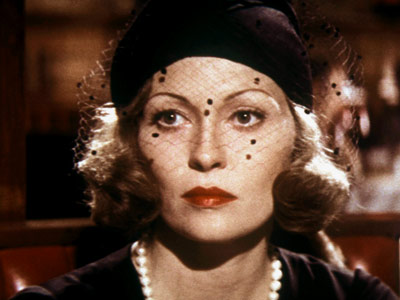
Roman Polanski called on memories of his mother when creating Faye Dunaway's stunning look in "Chinatown."
But it comes to light that the real Mrs. Evelyn Cross Mulwray (Dunaway) is the daughter of multimillionaire Noah Cross (John Huston). And she wants Gittes off the case – or she’ll sue. But when Mulwray’s body is found in an empty water reservoir, Evelyn wants Gittes back on her side. Once there, Gittes uncovers lots of facts that don’t add up – for instance, in the middle of a drought, water is being dumped. At the core of the mystery is a struggle for control of LA’s water supply.
There’s lots of money to be made and power to be gained if you can dry out vast patches of land, then buy them on the cheap. (The California water wars, a fight that started in 1898 over water rights between LA and other areas, including the Owens Valley, influenced Towne’s story.)
Gittes has his work cut out for him. The cops, led by Lieutenant Escobar (Perry Lopez), give him grief. Russ Yelburton (John Hillerman) and Claude Mulvihill (Roy Jenson) of the LA Water and Power Company don’t like him. A menacing man with knife (a cameo by Polanski) warns him not to be so nosy – and just to drive home the point, he slices off a bit of Gittes’ schnoz.
Once he’s cracked the case, though, Gittes can’t play the hero to the dishonesty, greed and perversion that surround him. The evil continues, unchecked. “As savior and restorer of a moral order, [Gittes is] a complete washout, a genre first,” writes Foster Hirsch in “Detours and Lost Highways: A Map of Neo-Noir.”
So why is this a great work of art? First, it looks so striking—vintage LA, poised to become a big city—and Polanski’s voyeuristic camerawork (from the viewpoint of a standing onlooker) lends dark sophistication. The bleak themes of betrayal and corruption give the film enormous power.
Then there’s Jerry Goldsmith’s score and of course Towne’s smart, sexy and funny dialogue. In an interview for the 1999 DVD re-release, Towne explains that he wrote the part with Nicholson in mind and was inspired by the actor’s temperament, manner and the way he uses language.
And despite the fact that Gittes’ character has roots in earlier screen detectives, such as Philip Marlowe, Towne says, “I tried to draw characters from life, not from film.”
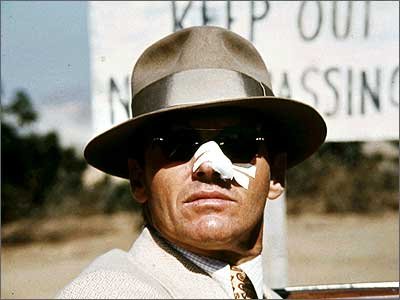
Private investigator Jack Gittes is one of the best performances of Jack Nicholson's lengthy and prestigious acting career.
Some of my favorite Gittes’ lines:
“I goddamn near lost my nose. And I like it. I like breathing through it.”
“He passed away two weeks ago and one week ago he bought the land. That’s unusual.”
“You’re dumber than you think I think you are.”
Huston, avuncular and charming, and Dunaway, delicate, otherworldly and aloof, turn in resonant, affecting performances. (Ali MacGraw and Jane Fonda were also considered for the part of Evelyn.) Polanski recalls on the DVD interview that between every take Dunaway touched up her makeup. Her thin eyebrows and Cupid’s bow mouth was a ’30s look he helped Dunaway create; it was inspired by memories of his mother.
Though alluring, glamorous and dressed to a T, Evelyn Cross Mulwray is not a femme fatale. As Towne says in the interview, Evelyn sets up the expectation of being a black widow, but she is the heroine of the movie, the one person in the film who is operating out of decent and selfless motives. [Read more…]
Comments
‘Chinatown’ quick hit
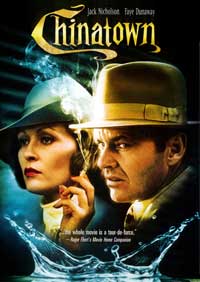 Chinatown/1974/Paramount Pictures/131 min
Chinatown/1974/Paramount Pictures/131 min
Few films rank as one of the best of their decade but that’s the case with “Chinatown,” a neo noir, set in 1937 California. Of the many things there are to admire, No.1 on my list is Jack Nicholson’s portrayal of private eye Jack Gittes. Secrecy and sex, profit and power, specifically control of the LA area’s water supply, are pieces of a potentially deadly puzzle that lands in his lap.
Also on the admiration list: performances from Faye Dunaway and John Huston, razor-sharp writing from Robert Towne, the mood of cool menace, and Roman Polanski’s directorial flair.
Comments
Surprise someone special with a tarot-card reading
For the holidays, occult treasure Madame Pamita is offering the chance to buy readings as gifts. Prices range from $10-$90, the certificates never expire and Madame Pamita will drop a note in the mail letting your recipients know they have a thoughtful, unique present from you.
During my reading at a Cinebar benefit over Labor Day weekend, she was sweet and soulful, perceptive and perspicacious. Her reading was oddly motivating as well – she knew I was up to something* and encouraged me to stick with it – a considerable feat, given my prodigious talent for lounging around, or as the Italians say: il dolce far niente – the sweetness of doing nothing.
What’s especially nice is that after your reading Madame Pamita records a brief summary so you can preserve the feeling of good tidings and growth that comes from her look at the cards. A reading is a fun surprise for just about anyone on your gift list. For more info, visit: www.madamepamita.com.
*Not to be confused with up to no good
Image courtesy of Madame Pamita
Comments
Jacques Tourneur, Robert Mitchum and Jane Greer make ‘Out of the Past’ required viewing
Out of the Past/1947/RKO/97 min.
As famed critic James Agee put it: “Robert Mitchum is so sleepily self-confident with the women that when he slopes into clinches you expect him to snore in their faces.”
While none of my Robert Mitchum fantasies involve snoring, I can’t say I’d kick him out of bed just for a few noisy ZZZs. One of Mitchum’s finest vehicles is “Out of the Past” (1947) by French-born director Jacques Tourneur.
If I happened to meet someone who wanted to know film noir and only had 97 minutes to live, this is the film I’d recommend. But pay close attention, little dying chum, because there are plot twists aplenty.
Mitchum plays Jeff Bailey (aka Jeff Markham) who runs a gas station in a small town. He’s seeking a quiet life, where he can put his messed-up past behind him. Ha! Free will doesn’t stand much of a chance in film noir, so when menacing Joe Stephanos (Paul Valentine) comes to town looking for Jeff, we know he’s about to be plunged back into the darkness.
Once Jeff learns that his former nemesis, gangster Whit Sterling (Kirk Douglas), wants a reunion, he decides to bring his pure and wholesome girlfriend Ann Miller (Virginia Huston) up to speed on his shady past and so launches a filigree of flashbacks with some of the most haunting images in all of noir.
Before he pumped gas, Jeff was a gumshoe whom Whit hired to find his double-dealing girlfriend Kathie Moffat (Jane Greer). Jeff finds her in Mexico, having escaped from Whit with a little help from a gun and a bigger helping of his money. It’s a long time into the flick before we see this fabulous femme fatale but when we finally do, she’s breathtaking. James Pallot in “The Movie Guide” calls Greer’s appearance “one of the greatest entrances in film history.”
Jeff, a self-confessed sucker, falls for her in about 3 seconds and decides that Whit Sterling can go to hell. As far as Whit’s cash, Kathie says she didn’t touch it and asks him: “Won’t you believe me?”
He replies: “Baby, I don’t care.”
The two relocate to San Francisco where they can hang incognito and go to movies (sounds divine!). Still, there’s that niggling bother of Whit, brilliantly played by Douglas, and he cares quite a bit.
Meanwhile, Jeff’s ex-partner in the detective biz Jack Fisher (Steve Brodie) catches up with the couple, angling for a pay-off to keep his mouth shut re: their new life. Jeff and Fisher come to blows, but Kathie decides to cut to the chase and shoot him dead.
Earlier Fisher comments: “A dame with a rod is like a guy with a knitting needle.” In fact, a knitting needle can double as a handy weapon but it’s far less efficient than a gun, as Kathie clearly knew.
Whit figures Jeff still owes him, and makes him part of the scheme to steal incriminating documents from attorney Leonard Eels (Ken Niles). In on the set-up is Eels’ secretary Meta Carson (Rhonda Fleming) a Jane Greer lookalike and good-time girl. Over drinks with Jeff and Meta, Eels remarks: “All women are wonders because they reduce all men to the obvious.”
“And so do martinis,” Meta says.
When Eels ends up dead, Jeff appears to be the fall guy, but he staves that off by hiding the body. The next snag? Kathie signed an affidavit (at Whit’s insistence, she says) that Jeff killed Fisher. But Jeff doesn’t give up easily and, after tracking the above-mentioned documents, is happy to exchange them for $50,000 and the affidavit.
As the treachery escalates and the bodies start piling up, Kathie has all her men exactly where she wants them, but then noir guys are awfully recalcitrant…
“Out of the Past” is director Jacques Tourneur’s noir masterpiece. In a series of celluloid paintings almost baroque in their intensity, Tourneur and director of photography Nicholas Musuraca create a seamless and sinister world that captivates from the first shot to the last. As Eddie Muller in “Dark City: The Lost World of Film Noir” describes it: Musuraca achieves “the richest chiaroscuro cinematography of any noir.” And as Michael Wilmington wrote in the Chicago Tribune, the movie is: “Moody and poetic, filled with some of the most strangely beautiful images ever to grace a crime movie.” [Read more…]
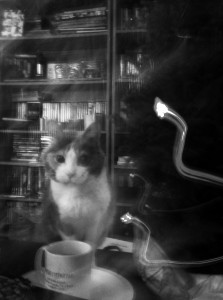





![2010-12-24_15.09.55[1]](http://www.filmnoirblonde.com/wp-content/uploads/2010/12/2010-12-24_15.09.551-300x225.jpg)
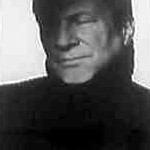
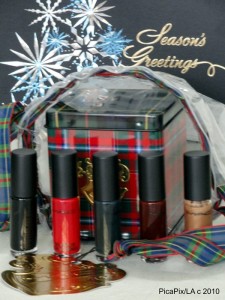
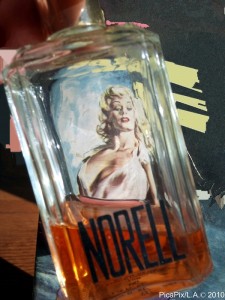
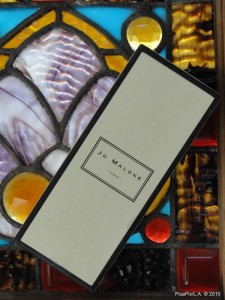
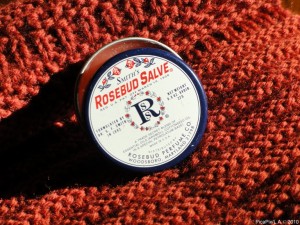
![12773[1] Madame Pamita's tarot readings](http://www.filmnoirblonde.com/wp-content/uploads/2010/12/1277311.jpg)
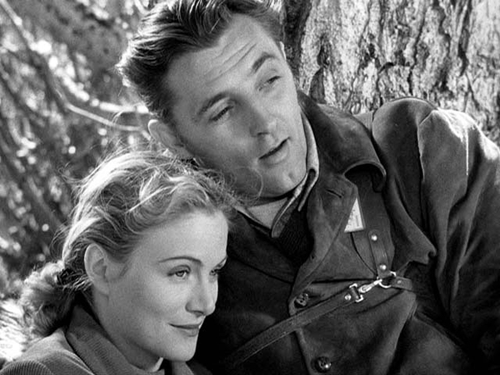
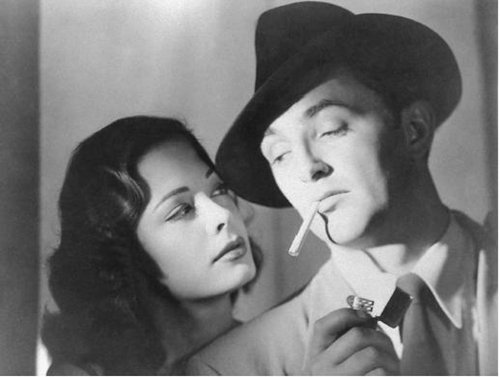





From FNB readers